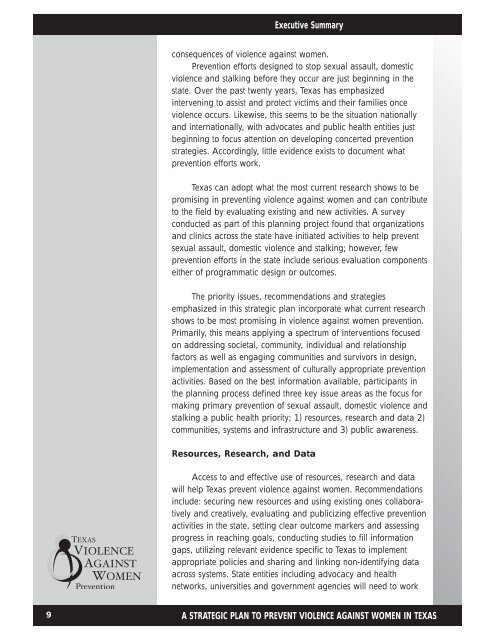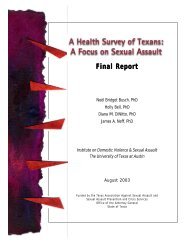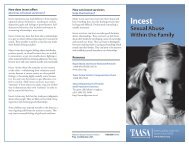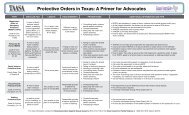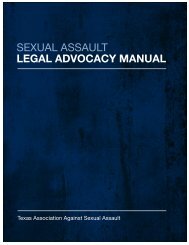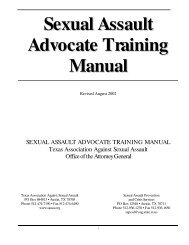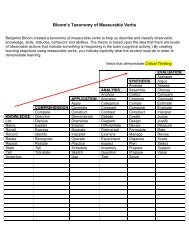TDH Booklet4 - Texas Association Against Sexual Assault
TDH Booklet4 - Texas Association Against Sexual Assault
TDH Booklet4 - Texas Association Against Sexual Assault
Create successful ePaper yourself
Turn your PDF publications into a flip-book with our unique Google optimized e-Paper software.
Executive Summary<br />
consequences of violence against women.<br />
Prevention efforts designed to stop sexual assault, domestic<br />
violence and stalking before they occur are just beginning in the<br />
state. Over the past twenty years, <strong>Texas</strong> has emphasized<br />
intervening to assist and protect victims and their families once<br />
violence occurs. Likewise, this seems to be the situation nationally<br />
and internationally, with advocates and public health entities just<br />
beginning to focus attention on developing concerted prevention<br />
strategies. Accordingly, little evidence exists to document what<br />
prevention efforts work.<br />
<strong>Texas</strong> can adopt what the most current research shows to be<br />
promising in preventing violence against women and can contribute<br />
to the field by evaluating existing and new activities. A survey<br />
conducted as part of this planning project found that organizations<br />
and clinics across the state have initiated activities to help prevent<br />
sexual assault, domestic violence and stalking; however, few<br />
prevention efforts in the state include serious evaluation components<br />
either of programmatic design or outcomes.<br />
The priority issues, recommendations and strategies<br />
emphasized in this strategic plan incorporate what current research<br />
shows to be most promising in violence against women prevention.<br />
Primarily, this means applying a spectrum of interventions focused<br />
on addressing societal, community, individual and relationship<br />
factors as well as engaging communities and survivors in design,<br />
implementation and assessment of culturally appropriate prevention<br />
activities. Based on the best information available, participants in<br />
the planning process defined three key issue areas as the focus for<br />
making primary prevention of sexual assault, domestic violence and<br />
stalking a public health priority; 1) resources, research and data 2)<br />
communities, systems and infrastructure and 3) public awareness.<br />
Resources, Research, and Data<br />
Access to and effective use of resources, research and data<br />
will help <strong>Texas</strong> prevent violence against women. Recommendations<br />
include: securing new resources and using existing ones collaboratively<br />
and creatively, evaluating and publicizing effective prevention<br />
activities in the state, setting clear outcome markers and assessing<br />
progress in reaching goals, conducting studies to fill information<br />
gaps, utilizing relevant evidence specific to <strong>Texas</strong> to implement<br />
appropriate policies and sharing and linking non-identifying data<br />
across systems. State entities including advocacy and health<br />
networks, universities and government agencies will need to work<br />
9 A STRATEGIC PLAN TO PREVENT VIOLENCE AGAINST WOMEN IN TEXAS


